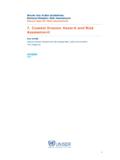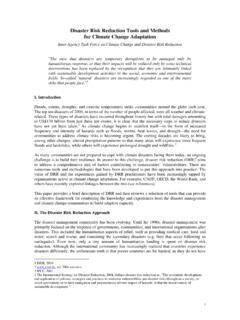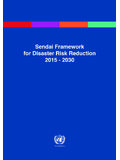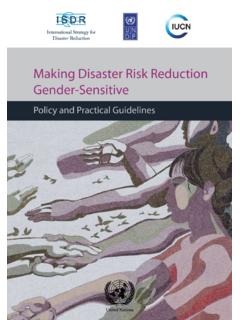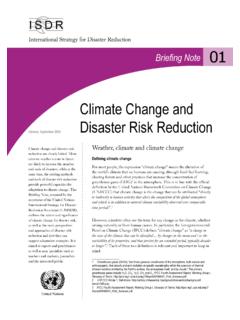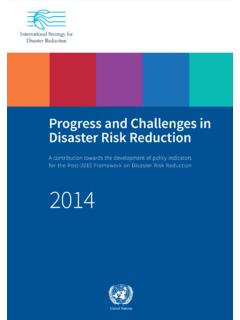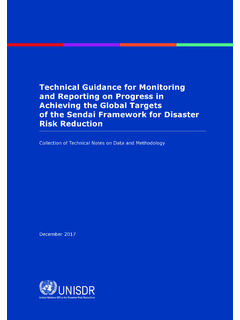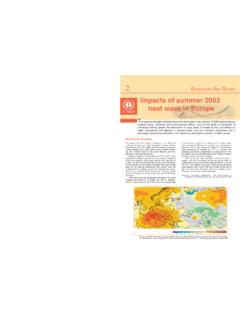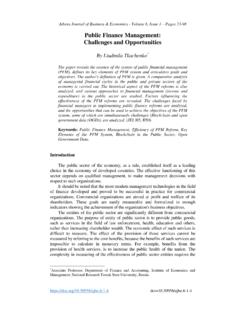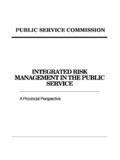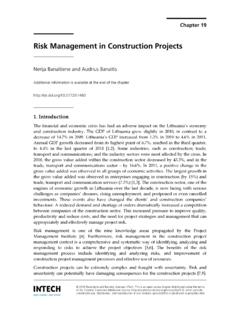Transcription of Disaster Risk Management - UNISDR
1 TOPICS 193. Disaster Risk Management Contributions by German Development Cooperation D I S A S T E R R I S K M A N A G E M E N T. Contents Foreword 3. 1. Aspects of global change why is Disaster risk Management important? 5. Climate change developing countries are particularly hard hit 10. Poverty reducing vulnerability to extreme hazards 14. Urbanisation and population growth Disaster vulnerability will increase 17. 2. Reducing Disaster risks the state of the national and international debate 20. 3. Disaster risk Management in development cooperation a key task of sustainable development 27. Risk analysis forward-looking investment planning in Peru's public sector 31.
2 Disaster prevention the example of Mozambique 33. Disaster risk Management in reconstruction in Indonesia 35. Disaster risk Management in schools the action of Sri Lanka's Ministry of Education after the tsunami 38. Disaster preparedness examples from Central America 40. 4. The outlook Disaster risk Management as a long-term commitment for development cooperation 44. Literature 47. Abbreviations 48. More Information 50. Imprint 52. 2. D I S A S T E R R I S K M A N A G E M E N T. Large-scale natural disasters frequently cause massive economic and environmental damage and inflict extreme suffering on the affected communities.
3 They are a significant impediment to development and put the attainment of the Millennium Development Goals at risk. In early May 2008, thousands of people were killed when Cyclone Nargis swept Myanmar. Soon afterwards, an earthquake devastated Sichuan province in China. Two neighbouring countries, almost simultaneously, thus had to deal with tens of thousands of dead and missing, ruined cities without power and water, and hunger and disease, all caused by these disasters. Heidemarie Wieczorek-Zeul, Federal Minister In August 2005, Hurricane Katrina highlighted for Economic Cooperation and Development the political, socioeconomic and cultural dimen- sions of these natural disasters and pitilessly demonstrated that even highly developed coun- tries such as the US are extremely vulnerable to the forces of nature.
4 The list of extreme Disaster events could continue indefinitely and there is However, experience also shows that people can a real threat that the frequency and intensity of and must prepare for extreme natural events. extreme weather conditions will increase as a Very often, previous mismanagement or deficits result of climate change. are factors which worsen the scale of the Disaster and could have been prevented by appropriate People in developing countries are particularly Disaster risk Management . With correct action at risk from the damage caused by natural disas- which takes account of natural processes, societies ters.
5 Poverty crucially influences the degree of can greatly reduce their vulnerability or even vulnerability to extreme natural events. prevent disasters such as mudslides or flooding Women are most at risk, as they account for from occurring at all. two-thirds of the world's extreme poor, often lack access to information (such as early warn- The international community has become ings), and do not always receive a fair share of increasingly aware of this nexus since the 1990s. aid. Statistics show that in the highly developed With strengthened resolve following the tsunami countries, the death toll in natural disasters av- in the Indian Ocean, the Hyogo Framework for erages 22 persons per Disaster .
6 In poor countries, Action (HFA, 2005), which builds on the UN's by contrast, every Disaster claims an average of International Strategy for Disaster Reduction 1052 lives. In poor countries, larger-scale natural (ISDR), was adopted by international, national disasters can also set back the development and non-governmental actors in Kobe, Japan, in process by many years or even decades. 2005. 3. D I S A S T E R R I S K M A N A G E M E N T. From now on, instead of passive Disaster from the outset in project/programme planning response, there is to be a far greater focus on and implementation in at-risk regions. Besides preventive Disaster risk Management .
7 Disaster our bilateral activities, we are also acting on our risk Management is to be integrated into devel- multilateral commitments and are supporting opment and sector planning and in poverty the operationalisation of the Hyogo Framework reduction strategies at all levels. for Action (HFA). For German development cooperation too, the This publication offers an insight into our efforts Disaster /development nexus is an important as- to date, our practical strategies and experiences. pect: without Disaster risk Management , the In view of global trends such as climate change, destructive force of natural disasters will contin- urbanisation and population growth, we must ue to wreak devastation, often reversing the face up to these challenges.
8 These trends show progress being made in the countries with that we should not underestimate the importance which we cooperate, worsening poverty and of Disaster risk Management for the attainment thus impeding sustainable development. of the Millennium Development Goals. We therefore fund projects which take account of Disaster risk Management and are already supporting numerous programmes in particu- larly vulnerable countries. Especially at-risk groups such as women, children and the elderly are a key focus of attention in this context. The aim is to mainstream Disaster risk Management 4. K A. D I ST AA SS TT ER RO PR H.
9 I SE KN VMOARNS AOGREGME E N T. 1. Aspects of global change . Why is Disaster risk Management important? 5. D I S A S T E R R I S K M A N A G E M E N T. The frequency and intensity of disasters is increas- It is likely that various global trends, including ing: a comparison of the decades 1980-1989 and climate change, urbanisation, population 1990-1999 shows that the number of major di- growth and poverty, will dramatically increase sasters increased from 63 to 91 and that economic the risk of Disaster , particularly in developing damage almost tripled (see Figure 1). In the countries. The following three sections illustrate decade 1997-2006 extreme weather events the connection between these trends and the alone caused 200,000 deaths and direct likelihood of Disaster , and pinpoint the implica- economic losses totalling more than tions for development cooperation.
10 EURO 450 billion (Germanwatch, 2008). What is a natural Disaster ? What is Disaster risk Management ? The International Strategy for Disaster Reduction Disaster risk Management comprises the whole (ISDR) defines a Disaster as a serious disruption of systematic and conceptual framework of measures the functioning of a community or a society involving that are closely linked to each other and that are widespread human, material, economic or environ- taken before a natural hazard occurs with the aim of mental losses and impacts which exceeds the ability limiting or avoiding adverse impacts of a natural of the affected community or society to cope using event on society.
